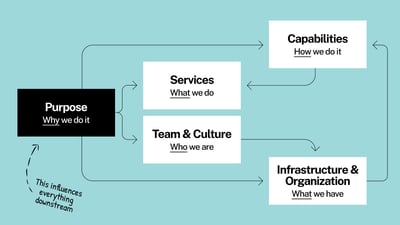Making Your Strategic Planning Communication Efficient and Inclusive

Boiling it down to two key takeaways:
- Along with people who dominate conversations, bias exhibited toward particular groups in meetings impedes the flow of good ideas, motivation, buy-in, and productivity.
- Communicating how to achieve inclusive strategic planning sessions is a good tool for creating a great plan.
Let’s unpack this article’s title a bit.
In far too many nonprofits, “efficient” and “strategic planning” are diametrically opposed. It’s like saying precise estimate or alone together or airline schedule. 😉
That’s because typical strategic planning relies on meetings, which in turn rely on agendas that often suffer blunt force trauma.
Some agenda items are over-talked, while others succumb to either stunted discussion or elimination due to time constraints. Not to mention topics bandied about that have nothing to do with the mission statement or were never on the agenda in the first place.
There’s freeform gabbing, repeated opinions, ill-equipped attempts at SWOT analysis, interruptions, and sometimes blame.
Moreover, things frequently tagged as “action items” become agenda bait for the next meeting, or they lack details like deadlines, who’s responsible, and how to get there from here.
In short, traditional strategic planning lacks efficiency because it relies heavily on unstructured meetings.
There’s no effective way to capture ideas, identify crucial challenges, and create solutions with actionable steps needed for real growth.
In addition to being inefficient, unstructured meetings are absent an inclusive strategy.
Think about your meetings. Probably like most, they’re dominated by the loudest voices in the room at the expense of others.
In fact, the Oregon Department of Human Services notes that in meetings with six or eight attendees, three people do 70% of the talking.
Often, these “dominators” are people in positions of power, like executives and managers. When they express an opinion, how many juniors in the command chain have an appetite to disagree?
Perhaps a courageous few—but that still leaves an overwhelmingly quiet majority in meetings, most of whom are victim to some sort of bias. For example:
- “Women are systematically seen as less authoritative…And their influence is systematically lower. And they’re speaking less. And when they’re speaking up, they’re not being listened to as much, and they are being interrupted more.” — Research results from Brigham Young University
- “Studies show women, people of color, and other underrepresented groups are often silenced, interrupted, dismissed, or talked-over at twice the rate of their colleagues.” — The Oregon Department of Human Services
- “More than 40% of black and Latina women reported being interrupted and spoken over in a work setting.” — Study by LeanIn.org and McKinsey & Co.
- Introverts tend to be less heard in meetings than extraverts — It’s not from shyness or fear of a social setting. Rather, numerous sources like Renee Cullinan note that introverts contribute best (a) after processing relevant data and (b) when they have the space to make carefully worded conclusions.
Thus—during the nonstop buzzing of extroverts—introverts are quiet and thinking, which is often confused for disagreement, disengagement, or a lack of expertise. By the time they’ve formed an appropriate response, the issue may have already moved on without their input.
Yes, these adverse behaviors should be eliminated for a more inclusive planning process. But how does that help us?
The benefits for instilling inclusiveness are numerous and significant. And quite honestly, as a nonprofit leader, you should insist on communicating how to do this for more effective strategic planning!
One of the more vital benefits is that of buy-in. Creating a space for all team members to share their perspectives gives them a stake in the strategic planning process. As such, even if their views are not reflected in what is eventually adopted, they’re more likely to support it.
Other notable benefits deriving from the inclusive workgroup:
- Motivation: Including team members in planning gives them a better understanding of the organization’s goals and prompts a higher level of engagement.
- Innovation: You benefit from a diversity of ideas and perspectives, which can create paths to pioneering strategies and unmask organizational blind spots.
- Efficiency: Employees who don’t feel invisible within their organizations report being more productive.
- Rewarding: Ultimately, clients get better programming, donors have greater impact, and board members are likely inspired to do more.
In a nutshell, being inclusive is just good business.
For instance, a global study by The Workforce Institute and Workplace Intelligence of over 4,000 employees found that “Highly engaged employees are three times more likely to say they feel heard at their workplace (92%) than highly disengaged employees (just 30%). And “74% of employees report they are more effective at their job when they feel heard.”
Okay, Matt, you’ve got a point—so how do we go about communicating to our team that we’re making our strategic planning inclusive?
This is where true leadership comes into play. Unless you’re already heading up a genuinely inclusive organization, you’ll need to communicate this cultural shift within your strategic planning process.
That means being in tune with hidden (and not so hidden) biases that can stunt original thought when your planning team meets. And importantly, those biases must be addressed by you (or your meeting facilitator) as they occur.
So—let’s get started!
Commit to Creating a Safe Space
Communicate to your entire strategic planning team that it’s safe for them to share ideas, to speak up without fear of dismissiveness or ridicule or interruption.
You can support this environment by ensuring moments of disrespect are called out, along with promoting active listening, asking questions, and encouraging feedback.
Communicate Boundaries and Ground Rules for Strategic Planning
In your first gathering, for example, make it clear you expect people to be on time. Stopping a conversation or activity for late arrivals (or getting them up to speed) is distracting, plus their tardiness shows a lack of respect for others.
Another good ground rule is declaring when people should or should not talk. For instance, our strategic planning process not only replaces meetings with workshops, it features some structured exercises in which attendees work silently (but together) to generate their own ideas.
Assign a Facilitator (or Hire One, Like CauseMic) to Enforce the Rules
The facilitator keeps things on track and on time and is instrumental in promoting effective strategic planning steps.
But a facilitator should also ensure as close to a bias-free workspace as possible. That means addressing and squelching behaviors such as:
- Interrupting a colleague
- Ridiculing or being dismissive of another’s opinion
- Dominating the conversation
Having a facilitator prevents everyone else in the room from either having to put up with inappropriate behavior or having to confront someone who exhibits it.
Build Your Strategy Collaboratively
We’ve found that structured exercises are incredibly productive for groups capturing new ideas and determining the best path forward.
For example, our problem-solving framework allows silent time for everyone to identify prominent challenges and to generate actionable solutions. They then share them publicly without interruption, and ultimately all vote on those they believe to be the most viable.
Adopting and communicating an inclusive process help ensure the best, most feasible notions surface from your team.
When you throw facilitated structure into the mix, you’re well on your way to a strategic plan capable of exponential growth.
It simply takes a leader to say, “We’re all in!”




